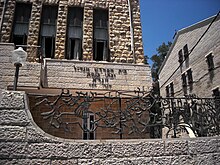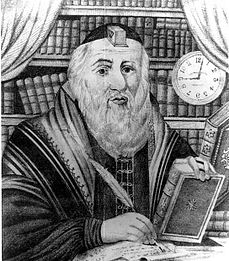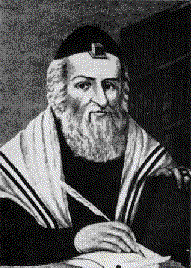Vilna Gaon
This article needs additional citations for verification. (December 2023) |
Elijah ben Solomon Zalman | |
|---|---|
 | |
| Title | Vilna Gaon Elijah of Vilna Gra |
| Personal | |
| Born | Elijah ben Solomon Zalman April 23, 1720 |
| Died | October 9, 1797 (aged 77) |
| Religion | Judaism |
| Nationality | Polish-Lithuanian |
| Denomination | Orthodox Judaism |
| Yahrtzeit | 19 Tishrei |
| Buried | Vilnius, Lithuania |
Elijah ben Solomon Zalman,[1] (Hebrew: ר' אליהו בן שלמה זלמן Rabbi Eliyahu ben Shlomo Zalman), also known as the Vilna Gaon[2] (Yiddish: דער װילנער גאון Der Vilner Goen; Polish: Gaon z Wilna, Gaon Wileński; or Elijah of Vilna, or by his Hebrew acronym Gra ("Gaon Rabbenu Eliyahu": "Our great teacher Elijah"; Sialiec, April 23, 1720 – Vilnius October 9, 1797), was a Lithuanian Jewish Talmudist, halakhist, kabbalist, and the foremost leader of misnagdic (non-hasidic) Jewry of the past few centuries.[3][4][5] He is commonly referred to in Hebrew as ha-Gaon mi-Vilna, "the genius from Vilnius".[6]
Through his annotations and emendations of Talmudic and other texts, he became one of the most familiar and influential figures in rabbinic study since the Middle Ages. Although he is chronologically one of the Acharonim, some have considered him one of the Rishonim.[7][8][9]
Large groups of people, including many yeshivas, uphold the set of Jewish customs and rites (minhag), the "minhag ha-Gra", named after him, and which is also considered by many to be the prevailing Ashkenazi minhag in Jerusalem.[citation needed]
Born in Sielec in the Brest Litovsk Voivodeship (today Syalyets, Belarus), the Gaon displayed extraordinary talent while still a child. By the time he was twenty years old, rabbis were submitting their most difficult halakhic problems to him for legal rulings. He was a prolific author, writing such works as glosses on the Babylonian Talmud and Shulchan Aruch known as Bi'urei ha-Gra ("Elaborations by the Gra"), a running commentary on the Mishnah, Shenoth Eliyahu ("The Years of Elijah"), and insights on the Pentateuch entitled Adereth Eliyahu ("The Cloak of Elijah"), published by his son. Various Kabbalistic works have commentaries in his name, and he wrote commentaries on the Proverbs and other books of the Tanakh later on in his life. None of his manuscripts were published in his lifetime.[citation needed]
When Hasidic Judaism became influential in his native town, the Vilna Gaon joined the "opposers" or Misnagdim, rabbis and heads of the Polish communities, to curb Hasidic influence.[10][11]
While he advocated studying branches of secular education such as mathematics in order to better understand rabbinic texts, he harshly condemned the study of philosophy and metaphysics.[12][13]
Youth and education
[edit]The Vilna Gaon was born in Sialiec, Polish–Lithuanian Commonwealth on April 23, 1720, as Elijah Ben Solomon Zalman to a well known rabbinical family.[4]
According to legend, the Gaon had committed the Tanakh to memory by the age of four, and at the age of seven, he was taught Talmud by Moses Margalit, future rabbi of Kėdainiai and the author of a commentary to the Jerusalem Talmud, entitled Pnei Moshe ("The Face of Moses").[4] He possessed a photographic memory. By eight, he was studying astronomy during his free time. From the age of ten he continued his studies without the aid of a teacher, and by the age of eleven he had committed the entire Talmud to memory.[citation needed]
Later[when?], the Gaon decided to go into "exile" and he wandered in various parts of Europe including Poland and Germany.[14] By the time he was twenty years old, rabbis were submitting their most difficult halakhic problems to him. He returned to his native city in 1748, having by then acquired considerable renown.[15]
Methods of study
[edit]The Gaon applied rigorous philological methods to the Talmud and rabbinic literature, making an attempt toward a critical examination of the text.[citation needed]
The Gaon devoted much time to the study of the Torah and Hebrew grammar, and was knowledgeable in scientific pursuits of the time.[16]
Antagonism to Hasidism
[edit]When Hasidic Judaism became influential in Vilna, the Vilna Gaon joined rabbis and heads of the Polish communities, to speak against Hasidic influence.[12][17]
In 1781, when the Hasidim renewed their proselytizing work under the leadership of their Rabbi Shneur Zalman of Liadi (the "Ba'al Ha'tanya"), the Gaon excommunicated them again, declaring them to be heretics with whom no pious Jew might intermarry.[citation needed]
Other work
[edit]Except for the conflict with the Hasidim, the Vilna Gaon rarely engaged in public affairs and, so far as is known, did not preside over any school in Vilna. He was satisfied with lecturing in his bet ha-midrash to a few chosen pupils, whom he initiated into his methods. He taught them Hebrew grammar, Hebrew Bible, and Mishna, subjects that were largely neglected by the Talmudists of that time. He was especially anxious to introduce them to the study of midrash literature, and the Minor Treatises of the Talmud, which were very little known by the scholars of his time.[citation needed]
He laid special stress on the study of the Jerusalem Talmud, which had been almost entirely neglected for centuries. The Gaon encouraged his chief pupil, Rabbi Chaim of Volozhin, to found a yeshiva (rabbinic academy) in which rabbinic literature should be taught. Rabbi Chaim Volozhin opened the Volozhin yeshiva in 1803, a few years after the Gaon's death, and revolutionized Torah study, with resulting impact on all of Orthodox Jewry.[18]
Asceticism
[edit]The Vilna Gaon led an ascetic life, being called by some of his contemporaries "the Hasid". This term meaning "pious person", and has no relevance to the Hasidic movement.[citation needed]
The Gaon once started on a trip to the Land of Israel, but for unknown reasons did not get beyond Germany. (In the early nineteenth century, three groups of his students, known as Perushim, under the leadership of Rabbi Menachem Mendel of Shklov, made their way to what was then Ottoman Palestine, settling first in Safed and later also in Jerusalem).[19] While at Königsberg he wrote to his family a famous letter that was published under the title Alim li-Terufah, Minsk, 1836.[citation needed]
Works
[edit]The Vilna Gaon was a copious annotator, producing many marginal glosses, notes, and brief commentaries, which were mostly dictated to his pupils. Many maintain that it was his disciples who recorded his comments, if not his editorial notes. However, nothing of his was published in his lifetime. The "Gra" was very precise in the wording of his commentaries, because he maintained that he was obligated by Torah Law that only the "Torah shebichtav" (the written law) is permitted to be written down - the rest of "Torah sheb'al peh" (oral law) cannot be, unless circumstances require. (This further supports the view that it was his disciples who wrote his comments.) So the Vilna Gaon abided by this view of law by reducing his extensive explanations that are largely inscrutable to any but advanced talmudists. Glosses on the Babylonian Talmud and Shulchan Aruch are known as Bi'urei ha-Gra ("Elaborations by the Gra"). His running commentary on the Mishnah is titled Shenoth Eliyahu ("The Years of Elijah"). Various Kabbalistic works have commentaries in his name. His insights on the Pentateuch are titled Adereth Eliyahu ("The Splendor of Elijah"). Commentaries on the Proverbs and other books of the Tanakh were written later on in his life.[citation needed]
The Gaon was well versed in the mathematical works of Euclid (4th century BC) and encouraged his pupil Rabbi Baruch Schick of Shklov to translate these works into Hebrew. The Gaon is said to have written a concise mathematical work called Ayil Meshulash, which was an introductory primer to basic mathematics.[16][20][21]
Influence
[edit]

The Gaon was one of the most influential rabbinic authorities since the Middle Ages, and—although he is properly an Acharon—many later authorities hold him as possessing halachic authority in the same class as the Rishonim (rabbinic authorities of the Middle Ages).[citation needed]
His main student Rabbi Chaim Volozhin, founded the first yeshiva in his home town of Volozhin, Belarus.[18] The results of this move is claimed to have revolutionized Torah study, by departing from the centuries of 'informal' study. Youth and scholars would congregate in local synagogues and study freely, although it was customary to migrate to towns possessing great scholars as the local rabbi. The Volozhin Yeshivah created a formal structure of the study, by providing qualified faculty, meals, and accommodation. The results of this process are currently the norm in Orthodox Jewry.
Somewhat ironically, viewed from a traditional light, the leaders of the Haskalah movement used the study methods of the Vilna Gaon to gain adherents to their movement. Maskilim valued and adapted his emphasis on peshat over pilpul, his engagement with and mastery of Hebrew grammar and Bible, and his interest in textual criticism of rabbinic texts, further developing the philosophy of their movement.[citation needed]
As for the Vilna Gaon's own community, in accordance with the Vilna Gaon's wishes, three groups of his disciples and their families, numbering over 500, made aliyah to the Land of Israel between 1808 and 1812.[22] This immigration was one of the first modern Jewish migrations to Palestine, although Hasidic immigration was already active in the 1780s (even by the rebbes themselves, such as the elderly Menachem Mendel of Vitebsk and Chaim Chaykl of Amdur). The disciples of the Vilna Gaon, known as Perushim due to how they isolated themselves from worldly concerns to study Torah, originally settled in Safed because the Muslim authorities in Jerusalem prevented Ashkenazi Jews from settling there. However, after numerous devastating calamities in the region, including plague and earthquake, most of the disciples moved to Jerusalem. Their arrival in Jerusalem, which for over 100 years had been mainly Sephardi, revived the presence of Ashkenazi Jewry in Jerusalem, and resulted in a dominance of the customs of the Vilna Gaon.[citation needed]
The impact of the Perushim is still apparent today in the religious practices of the Israeli Jewish community, even among non-Ashkenazim. For example, the institution of the priestly blessing by the Kohanim known as duchaning during the weekdays (rather than only during festivals, as practiced in the Diaspora), and the accepted time for the onset of Shabbat in Jerusalem and other cities can both be traced to the custom of the Vilna Gaon. However, the teachings and traditions of the Vilna Gaon have been passed down most directly to the Litvaks in Israel. The Perushim also set up several Kollels, founded the Jerusalem neighborhood of Mea Shearim, and were instrumental in rebuilding the Yehudah HeChassid Synagogue (also known as the Hurba Synagogue, or "The Ruins"), which had lain in ruins for 140 years.[citation needed]
A statue of the Vilna Gaon and a street named after him are in Vilnius, the place of both his birth and his death. Lithuania's parliament declared 2020 as the year of the Vilna Gaon and Lithuanian Jewish History.[23] In his honour, the Bank of Lithuania issued a limited-edition silver commemorative 10-euro coin in October 2020; this is the first euro coin with Hebrew letters.[24][25]
The Vilna Gaon's brother Avraham authored the revered work "Maalot Hatorah". His son Abraham was also a scholar of note.[citation needed]
Death
[edit]The Vilna Gaon died in 1797, aged 77, and was subsequently buried in the Šnipiškės cemetery in Vilnius, now in Žirmūnai elderate. The cemetery was closed by the Tsarist Russian authorities in 1831 and partly built over.[citation needed]
In the 1950s, Soviet authorities planned to build a stadium and concert hall on the site. They allowed the remains of the Vilna Gaon to be removed and re-interred at the new cemetery.[26]
See also
[edit]References
[edit]- ^ Within recent decades he has been given the surname Kremer. However neither the Vilna Gaon nor his descendants apparently used this surname, which means shopkeeper. It was possibly mistakenly derived from a nickname of his ancestor Rabbi Moshe Kremer. "The Vilna Gaon, part 3 (Review of Eliyahu Stern, The Genius)". Marc B. Shapiro
- ^ Yaniv, Samuel (Rabbi) (April 17, 2010). "The Vilna Gaon and his Vision of Redemption". Bar Ilan University. Archived from the original on March 23, 2017. Retrieved May 19, 2012.
- ^ Etkes, Immanuel; Green, Jeffrey M. (2002). The Gaon of Vilna: The Man and His Image. University of California Press. ISBN 978-0-520-22394-3. JSTOR 10.1525/j.ctt1pnj2v.
- ^ a b c Cohn-Sherbok, Dan; Cohn-Sherbok, Lavinia (1994). Jewish & Christian Mysticism: An Introduction. Gracewing Publishing. ISBN 978-0-85244-259-3.
- ^ Eisenberg, Ronald L. (December 1, 2011). Dictionary of Jewish Terms: A Guide to the Language of Judaism. Taylor Trade Publications. ISBN 978-1-58979-729-1.
- ^ The Threefold step of Academia Europeana: a case of Universitas Vilnensis, 2009, p. 24
- ^ Karelitz, Avraham Yeshaya. קובץ איגרות חזון איש [Collected letters of the 'Chazon Ish'] (in Hebrew). pp. Part one, section 32.
אנו מתייחסים להגר"א בשורה של משה רבנו, עזרא, רבנו הקדוש, רב אשי והרמב"ם. הגר"א שנתגלה תורה על ידו כקדוש מעותד לכך שהאיר במה שלא הואר עד שבא ונטל חלקו, והוא נחשב אחד מהראשונים,
- ^ Danzig, Abraham. זכרו תורת משה (in Hebrew). p. 31.
רבי אליהו חסיד, הוא היה עיר וקדיש כאחד מן הראשונים
- ^ Tzuzmir, Yekuseil A.Z.H (1882). שו"ת מהריא"ז ענזיל (in Hebrew). Lvov. pp. 40b.
ומהר"א מווילנא אשר כחו כאחד הראשונים
{{cite book}}: CS1 maint: location missing publisher (link) - ^ Bloomberg, Jon (2004). The Jewish world in the modern age. Jersey City, NJ: KTAV Publishing House. ISBN 978-0-88125-844-8.
- ^ Etkes, Immanuel (2002-05-30), "The Vilna Gaon and the Mitnagdim as Seen by the Hasidim", The Gaon of VilnaThe Man and His Image, University of California Press, pp. 96–150, doi:10.1525/california/9780520223943.003.0005, ISBN 978-0-520-22394-3, retrieved 2024-07-27
- ^ a b Satlow, Michael L. (2006). Creating Judaism: History, Tradition, Practice. Columbia University Press. ISBN 978-0-231-13488-0.
- ^ "Shulchan Arukh, Yoreh De'ah 179:6". www.sefaria.org. Retrieved 2023-12-30.
- ^ Green, David B. (October 9, 2012). "This Day in Jewish History 1797: The Vilna Gaon Dies". Haaretz. Retrieved November 7, 2017.
- ^ Schechter, Solomon; Seligsohn, M. "ELIJAH BEN SOLOMON (also called Elijah Wilna, Elijah Gaon, and Der Wilner Gaon)". Jewish Encyclopedia.
- ^ a b Stern, Eliyahu. "The Making of Modern Judaism: Interview with Eliyahu Stern". YIVO Institute for Jewish Research.
- ^ Wertheimer, Jack (2004). Jewish Religious Leadership: In Eastern Europe ; In Western and Central Europe ; In the United States ; In North Africa and Israel ; The representation of Jewish leadership. Jewish Theological Seminary. p. 407. ISBN 9780873340984.
- ^ a b Diamond, Robin (July 14, 2020). "Rabbi Mendel Kessin: End of the American Exile". blogs.timesofisrael.com. Retrieved August 18, 2020.
- ^ "The Vilna Gaon". National Library of Israel.
- ^ Matthews, Michael R. (2014). International Handbook of Research in History, Philosophy and Science Teaching. Springer. ISBN 978-94-007-7654-8.
- ^ Bollag, Shimon (2007). "Mathematics". In Skolnik, Fred (ed.). Encyclopaedia Judaica: Lif-Mek (2nd ed.). Detroit: Macmillan Reference USA in association with the Keter Pub. House. p. 676. ISBN 978-0-02-865941-1.
- ^ Morgenstern, Arie. Hastening Redemption.
- ^ Nutarimas Dėl Vilniaus Gaono Ir Lietuvos Žydų Istorijos Metų Minėjimo 2020 Metais Plano Patvirtinimo
- ^ Liphshiz, Cnaan (October 24, 2020). "Lithuania mints first-ever EU coin with Hebrew letters, honoring Vilnius scholar". The Times of Israel. Retrieved October 26, 2020.
- ^ "Bank of Lithuania issues a silver coin dedicated to a famous Sage—the Vilna Gaon". Lietuvos bankas. Retrieved 2020-12-24.
- ^ "Jews protest to Lithuania over ancient cemetery". Reuters. 2007-08-22. Retrieved 2007-08-22.
Bibliography
[edit]- Ackerman, C. D. (trans.) Even Sheleimah: the Vilna Gaon looks at life (Targum Press, 1994) ISBN 0-944070-96-5
- Etkes, Immanuel, et al. (2002). The Gaon of Vilna: the man and his image (University of California Press) ISBN 0-520-22394-2
- Etkes, Emanuel (1989). "The Gaon of Vilna and the Haskalah movement", by Emanuel Etkes, reprinted in Dan, Joseph (ed.). Studies in Jewish thought (Praeger, NY) ISBN 0-275-93038-6
- Freedman, Chaim. Eliyahu's Branches: The Descendants of the Vilna Gaon (Of Blessed and Saintly Memory) and His Family (Avotaynu, 1997) ISBN 1-886223-06-8
- "The mystical experiences of the Gaon of Vilna", in Jacobs, Louis (ed.). Jewish mystical testimonies (Schocken Books, NY, 1977) ISBN 0-8052-3641-4
- Landau, Betzalel and Rosenblum, Yonason. The Vilna Gaon: the life and teachings of Rabbi Eliyahu, the Gaon of Vilna (Mesorah Pub., Ltd., 1994) ISBN 0-89906-441-8
- Rosenstein, Neil. The Gaon of Vilna and his Cousinhood (Center for Jewish Genealogy, 1997) ISBN 0-9610578-5-8
- Schapiro, Moshe. Journey of the Soul: The Vilna Gaon on Yonah/Johan: an allegorical commentary adapted from the Vilna Gaon's Aderes Eliyahu (Mesorah Pub., Ltd., 1997). ISBN 1-57819-161-0
- Shulman, Yaacov Dovid. The Vilna Gaon: The story of Rabbi Eliyahu Kramer ( C.I.S. Publishers, 1994) ISBN 1-56062-278-4
External links
[edit]- Jewish Encyclopedia (1906) entry for "ELIJAH BEN SOLOMON (also called Elijah Wilna, Elijah Gaon, and Der Wilner Gaon): (Redirected from ELIJAH GAON.)," by Solomon Schechter and M. Seligsohn
- Encyclopaedia Judaica (2007 - 2nd edition) entry for "Elijah Ben Solomon Zalman"," by Israel Klausner, Samuel Mirsky, David Derovan, and Menahem Kaddari
- A Precious Legacy Works of the Vilner Gaon Eliyahu b. Zalman
- Biography from the Vilna Gaon Jewish State Museum


